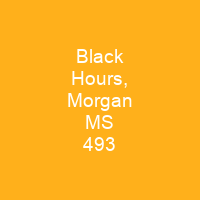The Black Hours, MS M. 493 is an illuminated book of hours completed in Bruges between 1460 and 1475. It consists of 121 leaves, with Latin text written in Gothic minuscule script. The words are arranged in rows of fourteen lines, and follow the Roman version of the texts. The lettering is inscribed in silver and gold, and placed within borders ornamented with flowers, foliage and grotesques.
About Black Hours, Morgan MS 493 in brief

MS. 491 is a masterpiece of Late Gothic manuscript illumination. The book is often attributed, on stylistic grounds, to a follower of Willem Vrelant, a leading and influential Flemish illuminator. The circumstances of its commission are unknown, but its uniquely dark tone, expense of production, quality and rarity suggest ownership by privileged and sophisticated members of the Burgundian court. The black books were more highly regarded than conventional illuminated books ofHours. They can be assumed to have been produced for high-ranking members of society, probably from the court of Philip the Good or Charles the Bold. Black books were likely intended for high nobility: the uncommon colour of the pages supposedly carried an almost mystical aura for the owner. The effect was achieved by soaking the vellium in black dye or ink before they were lettered with gold and silver leaf. The text uses a masculine form of the Latin noun ‘pro meccatore’ which indicates a man, and the manner of the figures in the book is consistent with his style.
You want to know more about Black Hours, Morgan MS 493?
This page is based on the article Black Hours, Morgan MS 493 published in Wikipedia (as of Nov. 03, 2020) and was automatically summarized using artificial intelligence.







